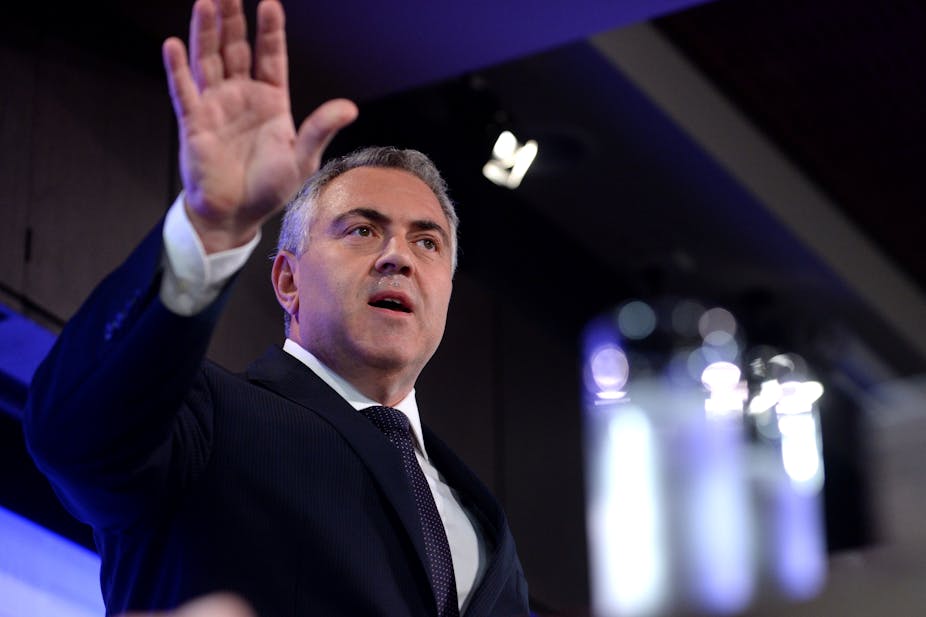Sooner or later, the Abbott government will have to stimulate the economy using fiscal policy – just like the Rudd government did in response to the global financial crisis and the Howard government did in 2001. That was the key message to come from the Mid-Year Economic and Fiscal Outlook (MYEFO), released by treasurer Joe Hockey yesterday.
The Abbott government has promised to cut taxes and spend a lot of extra money on new initiatives such as paid parental leave. The result will be a big hit to the budget deficit that, from opposition at least, they cared so much about.
It is therefore essential for the Coalition to start blaming the ALP for the indefinite budget deficits that Treasury is now predicting. Incoming conservative governments have been “discovering” budget black holes for decades.
This year’s MYEFO
The following table summarises the movement, in billions of dollars, between the Pre-Election Economic and Fiscal Outlook (PEFO) and the Mid-Year Economic and Fiscal Outlook (MYEFO).

The table shows that the outlook for this financial year has gone from a projected deficit of A$30.1 billion to $47.0 billion. Of that $16.9 billion change, $10.3 billion was the result of new policy changes announced by the Abbott government.
The rest ($6.6 billion) was a result of changes in economic growth, unemployment and other factors that influence taxation revenue and government spending on items such as unemployment benefits. Such variables are enticingly summarised by Treasury as “parameter changes”.
Most of the policy change section is due to the injection of $8.8 billion into the Reserve Bank of Australia (RBA) in 2013-14. While this has been treated as an “expense” by treasurer Joe Hockey, as the RBA is 100% owned by the Commonwealth, in reality, this “expense” it is simply a transfer from one Commonwealth account to another.
Leaving aside the accounting treatment of the RBA transfer, MYEFO suggests that “parameter changes” will account for 92% of the deterioration in the budget over the forward estimates. Neither the ALP nor Coalition are responsible for world economic growth. And, ironically, if the Coalition wants to boost the domestic economy, the worst thing it could do is engage in the big spending cuts it has foreshadowed.
The MYEFO now projects deficits for the next 10 years. It is interesting to note that before the global financial crisis, Treasury was projecting indefinite budget surpluses. But leaving aside the poor forecasting ability of the economics profession, the MYEFO rightly suggests that, with slower growth, unemployment is likely to rise from 5.8% now to 6.25% in 2014-15.
Significantly, there is no plan in the MYEFO to get the economy out of the slump. It looks like staying there for some time.
What can the Abbott government do?
In coming to power in 1996, prime minister John Howard was quick to find his “budget black hole” and to cut government spending on social and welfare policies in his fight against “Labor’s debt”. However, when the economy started to look a bit fragile, the old Keynesian language returned and we witnessed a defence of deficit spending in the 2001–02 budget.
Treasurer Peter Costello’s budget papers that year stated:
The government has provided a moderate stimulus in the 2001–02 Budget through targeted tax reductions, discretionary spending and by allowing the Budget to respond to the temporary slowdown in economic growth (through the operation of the “automatic stabilisers” which reduce tax revenues and increase expenditure). This is an appropriate policy response to recent economic developments.
Put simply, Costello did in 2001 what Wayne Swan did as the economy slowed in 2008. That is, he let the deficit grow to boost the economy. The multibillion-dollar question for Joe Hockey is whether he will put the Coalition’s slogans from opposition ahead of the economic advice he is receiving from Treasury.
With unemployment expected to rise, we are likely to need a second post-GFC stimulus. That should involve increases in the payment rates for Newstart and related payments such as Austudy and the other non-pension payments.
In the past, community groups – including the Business Council – have called for modest increases to welfare payments such as Newstart. However, the singles rate is now over $100 below the pension, and families with children relying on Newstart are 20% below the poverty line. Increasing these payments would address poverty in Australia and form part of a stimulus package that will be needed very soon – if not now – in anticipation of the worsening foreshadowed in the MYEFO.
We might reflect on the fact that it is very difficult to find one person in Australia who is personally suffering as a result of the level of debt or deficit at the moment, yet there are 712,500 unemployed people and their families who are in dire circumstances.

